The July Weiss Schwarz announcement came with a change in the ban list. We will be sharing the changes and giving our opinions as well. The banlist will be live after July 13th, 2024.
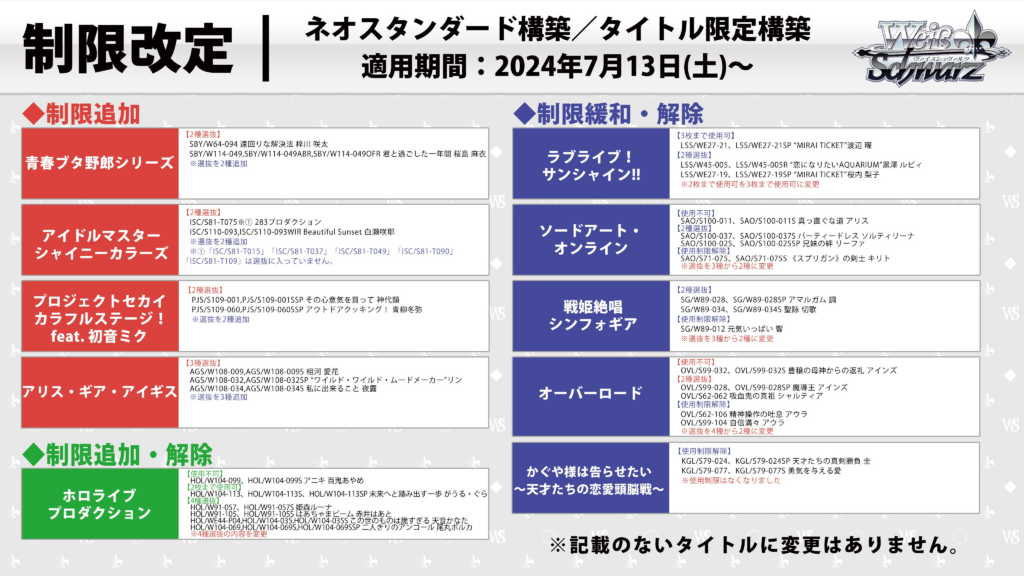
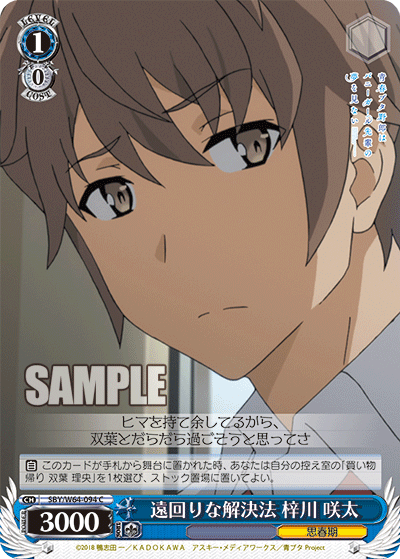

SBY/W114-049ABR-ABR 君と過ごした一年間 桜島 麻衣 (right)
To begin with, Bunny Girl Senpai is on the chopping block. Bunny Girl has two cards in a pick one list between the 1/0 Sakuta on the left and the 3/2 Mai finisher on the right. This ban is quite interesting. For those who are unaware, Mai has a rather somewhat hard condition needed to fulfill and optimize her total damage instances. That is to say that Mai wants to fill your memory with as many differently named cards as possible. The main issue is outside of a single option, all of Mai’s memory cards cost stock. That means while you are fulfilling Mai’s condition, you’ll be going net neutral or barely generating stock per turn as all of it will be used to pay for the memory conditional cards’ expenses. Sakuta on the left proposes an interesting solution to help fix Mai’s rather stock heavy needs.
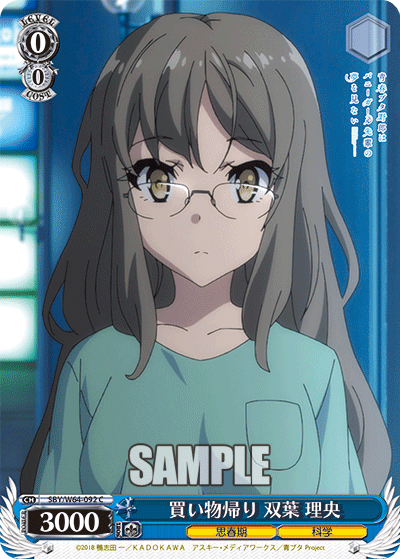
Sakuta stocks this specific Rio from waiting room when he’s played on stage from hand. Given the lack of options that provide additional stock freely without a combo, Sakuta is one of the only cheap ways to make up for Mai’s costs. The loss of this pairing could be quite detrimental to the deck at its core. Mai will either have to try and stall for additional turns. Although, an alternative does exist.
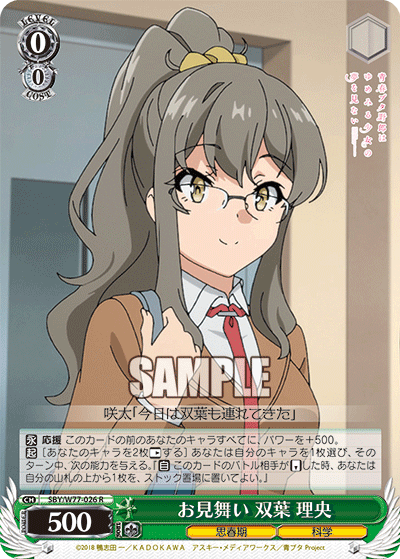
The Futaba above can act as a stand-in for the 1/0 Sakuta and 0/0 Futaba pairing. This card is a bit slow and does have its own host of problems. Sakuta’s strength laid in the fact that he would immediately generate you stock on play. His stock was also clean and could be used immediately. However, one obvious downside was the hard requirement of having to run copies of the 0/0 vanilla Futaba. Futaba above, in comparison to Sakuta, is an assist that can be continually used to generate stock instead of simply on play. Her downside lies in the fact that her activated ability carries a heavy cost (resting two characters) and is also conditional, giving a character the ability to blind stock upon reverse. However, since 1/0 Sakuta is gone, that means that players will likely also move away from playing the 0/0 vanilla Futaba as she serves very little purpose without him. This assist Futaba also opens up additional slots in the deck, allowing for other options to be ran. The most obvious concern with Futaba lies in the fact that, unlike Sakuta, in the early game, her tap two ability is quite expensive. Most commonly, you’ll be keeping her in the back row alongside your brainstorm. Given that you obviously want to maintain attacks while damaging your opponent’s board and pushing damage, Futaba will likely require you to rest herself and the brainstorm, denying you the brainstorm’s activated ability. Given all this and more, we’ll just have to see how players will have to adjust without the 1/0 Sakuta and 0/0 vanilla Futaba combo.
Personally, I would have wished for some limitation to 3/2 Mai herself, dropping her down to two copies. Her ability may be random, but if you get her full requirements, she’s offering three additional damage instances outside of just her swing.
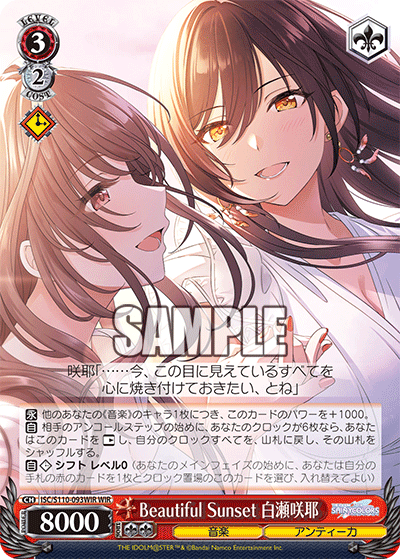
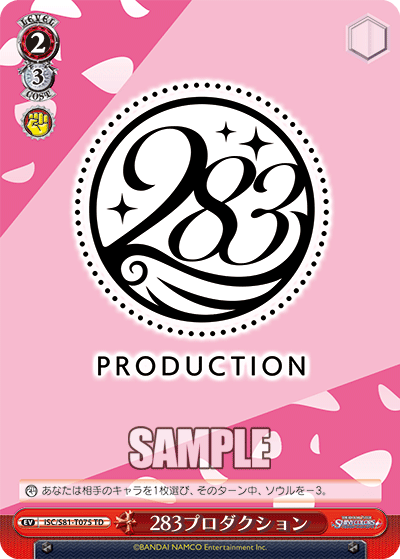
In a surprise ban, considering how new the set is, Shinym@s received its first limitation. There’s been a rising standby deck as of recent featuring both level one Mano and level three Fuyuko. As an eight standby deck and having the rare access to the niche profile of Saya, Shinym@s can summon the profile on the left featuring Sakuya and Kogane as early as level two. As a short summary of Saya, players could potentially heal their entire clock given the right circumstances and remain at level two for another turn or two. To help aid in this process, players would often play the event on the right, a soul reduction counter that would be effective on its own as a pseudo money counter. As a result, this banning will make it harder for players to try and trigger Sakuya’s ability and/or stall out the game with the soul reduction counter.
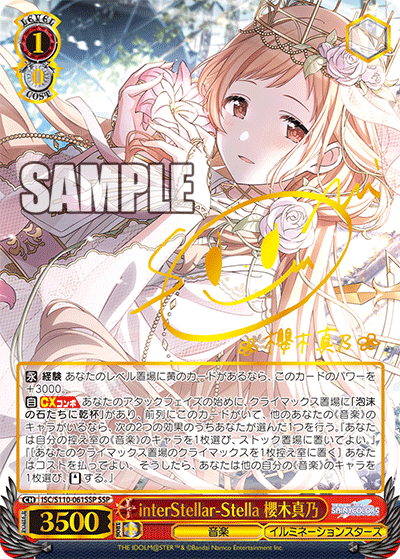
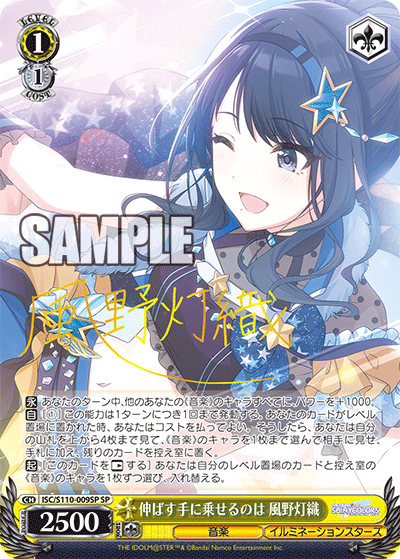

ISC/S110-009SP-SP 伸ばす手に乗せるのは 風野灯織 (center)
ISC/S110-004SSP-SSP たそかれスワッグ 八宮めぐる (right)
Now, what the standby deck is really doing is using the Illumination Stars (イルミネーションスターズ) engine above to work coincidentally with generic standby triggers to generate excess value. Most commonly, variants are of either new 3/2 Fuyuko or old 3/2 Mano are played with their finishing climax. Illumination Stars’ new core is quite powerful. Mano is a strong modular combo that lets you either stock a character from your waiting room at the start of your attack phase or sacrifice the climax at the same time to stand a character on stage. Mano’s modality gives you options to use to cater to your situation.
Now to understand the power of Mano, we must first consider the design of her climax, a standby trigger. Standby’s strength is in growing board. Very often, their combos require external assistance, having extra requirements, or simply only restand a character. Mano’s combo gives both stock and stands a character. Furthermore, unlike some older standby combos that gain extra resources, Mano is costless. Now on its own, Mano herself is great, but consider the addition of her two other bandmates, Hiori and Meguru. Hiori is a level swapper that grants both hand and global power while also ensuring you meet your experience requirements. Hiori is a singular card that provides many aspects that standby wishes for. Hiori can mill targets into your waiting room from deck, exchange stock for hand, and also help you beat down on your opponent’s cards during your turn. Meguru is a relatively cheap finisher when you consider her abilities and costs. She has a caveat of requiring three different colours in clock for her finishing ability, but thanks to Hiori, you’ll almost always be guaranteed to fulfill her condition. Given that Meguru is an off-finisher that doesn’t require any climax, Meguru can be slotted into any deck with low requirements and a powerful modular ability.

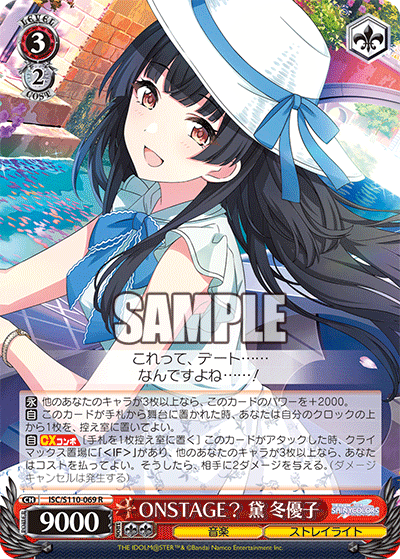
The golden question is then, what should be done to maybe tone down this deck should it become a problem? Shinym@s as a whole is a relatively new set, so it was quite surprising to see a banlist restriction this early after its release. Hitting the entire engine would be devastating to a pure Illumination Stars deck. Banning Mano or Hiori will heavily reduce the deck’s power while also weakening the consistency for Meguru. However, once again, hitting either of those would heavily punish Illumination Stars. So instead, I think the best option would be forcing a choice list between that of level three Fuyuko and level one Mano. Taking away Illumination Stars’ engine from a standard standby deck will allow a pure Illumination Stars player to run their deck without worry while also lowering the power of current standby iterations.
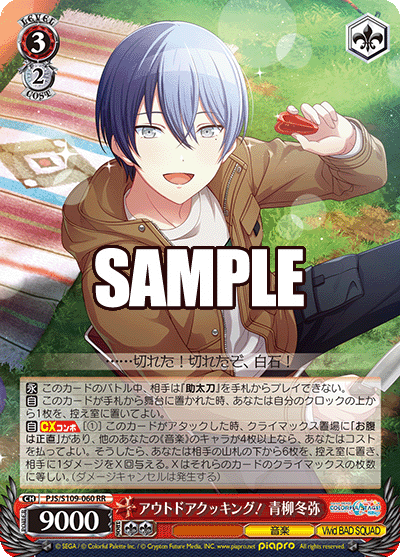
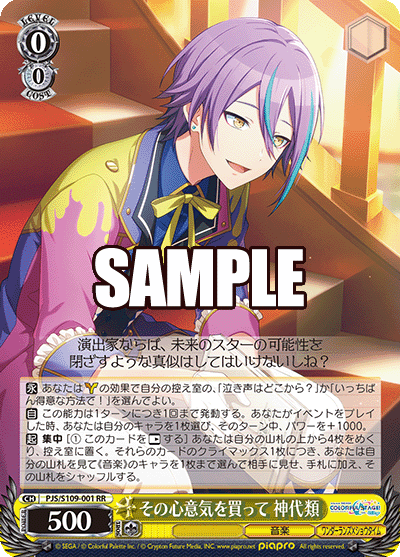
PJS/S109-001RR その心意気を買って 神代類 (right)
The next limitation to mention is that of Touya and Rui here from Project Sekai. Project Sekai has had quite a bit of an impact on the game following its second set release. One common combination is using the Touya finisher from Vivid Bad Squad (Vivid Bad Squad) paired with that of the Wonderlands x Showtime (ワンダーランズ×ショウタイム) archetype.
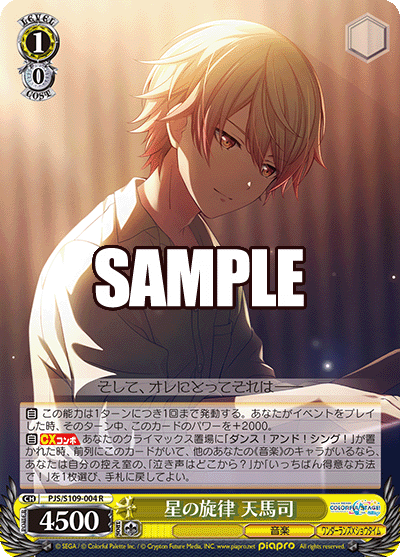
Rui’s limitation is more so a light ban to that of Tsukasa above. Tsukasa is a powerful combo that nabs one of two different events to hand from your waiting room. Furthermore, Tsukasa gains power once per turn whenever you play events. To make Tsukasa even stronger, Rui, a member of his band and the brainstorm on the limitation list, grants even more additional power whenever an event is used. Rui and Tsukasa make a scary pairing, and this isn’t even considering the additional ability of Rui to allow you to salvage or stock either of the events on Tsukasa’s combo salvage ability as an extra bonus if you trigger a choice icon. Overall, this powerful pair is already super powerful as is, and to provide them with a powerful pay-off in the late game, Touya was the perfect third partner.
Similar to a Shiny Colours limitation I had suggested, this is the exact same case. I think making Touya, Tsukasa, and Rui, play in their respective archetype decks makes the decks more fair.
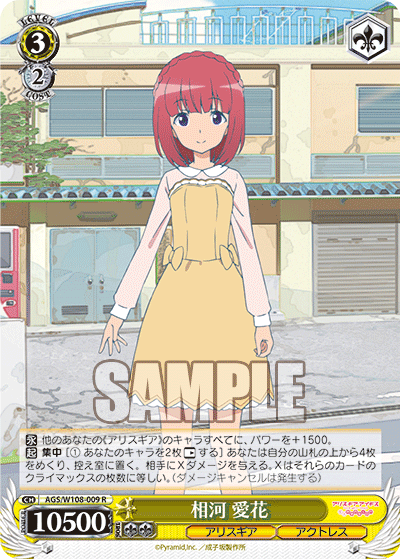

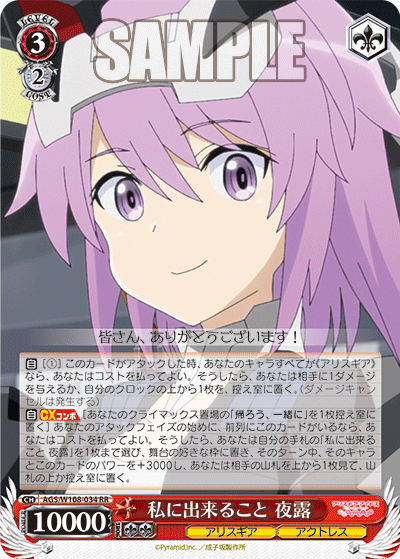
AGS/W108-032RR “ワイルド・ワイルド・ムードメーカー”リン (center)
AGS/W108-034RR 私に出来ること 夜露 (right)
Alice Gear has had its most prominent deck list take quite a bit hit this turn around. For those unfamiliar with how the deck runs, essentially you climb a standby ladder to spawn the 3/2 Yotsuyu on the right. Yotsuyu would then spawn another copy of herself with her climax combo. Yotsuyu is a very powerful card in her own right. The main reason for this is because of Yotsuyu’s first ability to cheaply pay a stock to either inflict a point of damage or heal your clock when she swings. Given how the combo works, you may even be able to spawn Yotsuyu as early as level one, making her incredibly difficult for your opponent to deal with unless they have multiple early-play answers.
The deck had a couple of little nuances to consider. Firstly, due to the nature of the combo, the player had to quickly assemble the pieces as soon as they could. The most powerful card to do this was the Riki profile Rin in the center that also carried an on-play surveil. Couple this with the fact that she is a double instance Riki profile, activating when she’s played on stage and when she’s sent to waiting room as well, she was an easy way to quickly nab your pieces as needed. Secondly, despite Yotsuyu being able to spawn out quite early, Yotsuyu doesn’t exactly have a high damage ceiling. Yotsuyu’s damage with her combo is capped with her innate ability and the single card Moca ability she has with her climax combo. Yotsuyu isn’t particularly defensively strong either. To help with this, Aika was a global support that also carried her own brainstorm finishing ability. Considering that the deck didn’t really need climaxes to allow for increased damage instances, Aika could turn these cards into damage instances themselves, both powering Yotsuyu and also providing the additional damage from the safety of the backrow or front row if need be (Aika allows you to tap any two characters for her ability).
This standby variant of Alice Gear was quite frustrating to play against. Either the opposing player had adequate answers in the early game or had quick access to them or Yotsuyu would run out of control. Keep in mind that Yotsuyu can heal the player for a cheap cost. Even if the player would not generate many resources, they could always just stall out their opponent and run them out of resources if they could maintain their Yotsuyu(s) on stage.
With this banlist, players will have to find other ways to assemble the package. Furthermore, with Aika gone, they’ll have to find another substitute to supplement Yotsuyu.
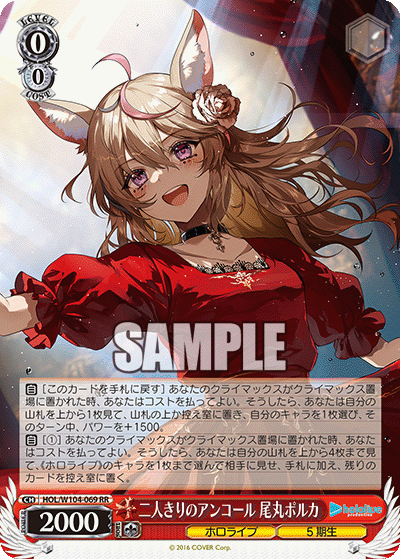
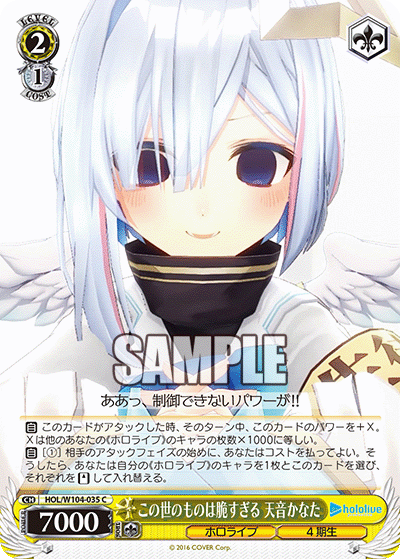
HOL/W104-035C この世のものは脆すぎる 天音かなた (right)
The last hits to the chopping block are within the Hololive set. This time, instead of targeting the little shark, Gura, Bushiroad has gone after the popular standby variant. The two cards above, Polka and Kanata, were essential pieces that supported the deck. Beginning with Polka, Polka was a phenomenal card that was a one-card toolbox that performed multiple duties for the deck. Firstly, since Luna’s deck was a standby deck, playing profiles that bounce back to hand and open a slot are always great to help preserve hand and be efficient with your field. However, that wasn’t all that Polka did. Polka would bounce back and also give a character the ability to surveil and grant them power for the turn. The power was already a nice bonus but being able to surveil the top card of your deck allows you to push deeper into your deck to potentially check for further standby triggers. Furthermore, Polka also carried an Amagi ability to add a character to hand while also milling your deck to fill your waiting room with standby targets. Polka was a huge consistency card that firmly aided Luna in getting her cards onto field while giving the player a number of benefits.
Kanata, on the other hand, is a defensive card that can swap onto different spots on your stage at the start of your opponent’s attack phase. This is heavily important because Kanata would often shift herself into Luna’s position, saving Luna from any potential reverser such as a level zero stock bomb or other level zero reversers. With Kanata in play, the player could often save at least one lane or even two if they are lucky with that safety net in play. Furthermore, this would often force opposing players to crash into Luna, securing another point of damage.
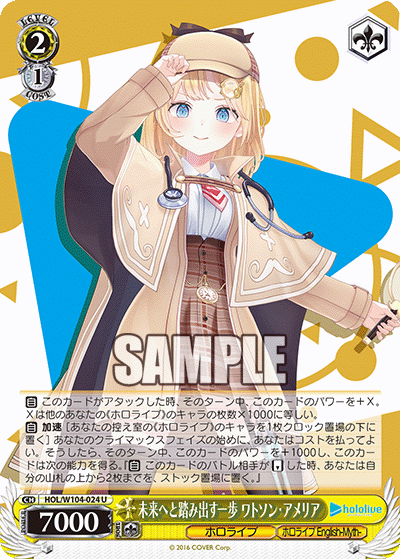

HOL/W91-049S-SR ときのそら (right)
Beginning with the unbans, starting off with Amelia Watson, Gura has her signature partner in crime back. Amelia, or Ame as she’s called by her fans, was a notorious piece that greatly aided in getting the needed stock to secure Gura’s combo. Amelia’s unban means that standby Gura now has its primary target back. However, Gura is still limited to two copies, so we’ll just have to see if this is enough to bring Gura back to form. Furthermore, many players are moving onto playing Gura’s archetype variant instead with nearly pure Hololive English-Myth- (ホロライブEnglish-Myth-) starring Mori Calliope level one combo.
Tokino Sora’s brainstorm and Pina profile being removed from the list does raise a few concerns. With her being unlimited, it is possible to run 3/2 Sora -2 soul once again. This card was essential in performing double duty to both provide value as a brainstorm and a safety net to keep 3/2 Sora around. The biggest observation to note is that Sora is unlimited and can be played in function with Haachama rest counter. Now, Sora was not a deck that made immense hand value, so we’ll have to see if there will be some sort of interaction here again.
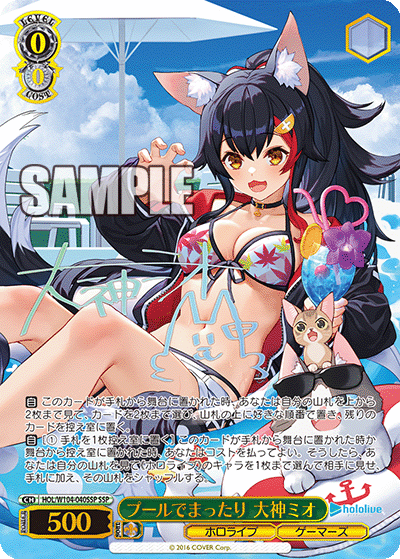

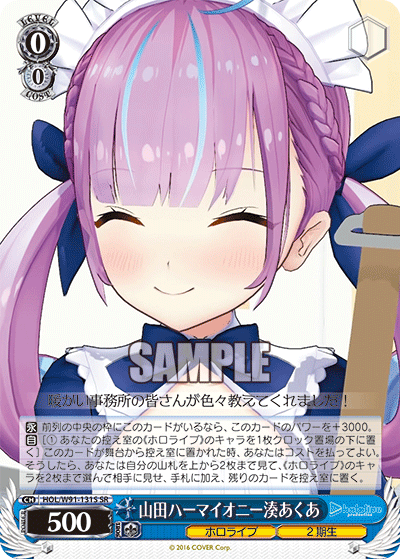
HOL/W104-074R 二人きりの時間… パヴォリア・レイネ (center)
HOL/W91-131S-SR 山田ハーマイオニー湊あくあ (right)
Some additional bans I would have wished to have been considered are shown above. I have heard others talk about how it feels like Hololive as an entire set needs to be either revised or banned as a whole. Now I do think they are speaking with a bit of hyperbole. Personally, from what I’ve personally witnessed and observed, there are key cards that are really causing the current trouble with Hololive.
Cards in Hololive are completely splashable into any deck with little to no restriction. Now this isn’t exactly new to Hololive as other series before have removed the trait restriction long ago. However, Hololive is an extremely large set that’s modern and carries quite a number of unique utilities and combinations of abilities on cards. Take Da Capo for example. Da Capo is probably one of the series with the largest card pools in the game. This series also continues to get support. However, despite this, Da Capo’s card pool is largely unused for the most part. There are design conflicts and strict requirements. Furthermore, a large chunk of cards are from the original set which have little modern repeatability outside of one or two exceptions. This is not the case for Hololive.
These three cards above are some of the most commonly seen cards I’ve found in many variants of Hololive decks. There are more of course, but I personally find these cards the most egregious. One reason for all three is that they all have the ability to be enablers in one way or form for most decks. Take Mio for instance, this card is a splashable drop search that works both on-play and when sent to waiting room. That alone is already a super powerful ability as it gives the card double utility in two different instances. However, on top of that, she also has the ability to check two and rearrange or surveil both cards. If you are playing a deck that is reliant on triggers such as that of standby decks, Mio is a perfect card for the job while also adding to the consistency of your deck. You can even standby over her to force her waiting room timing to activate.
Reine presents a more unique problem. The Riko profile is one of the most powerful abilities in Weiss Schwarz as is. You can transform any card into another card from your waiting room, usually a level zero based on how most modern deck building ratios work. However, on top of this, Reine is a huge value engine that can also potentially bounce back to hand upon cancel (when battle damage she takes is cancelled) to let you reuse her. The Aqua profile, a profile that is fairly common in most series now, is an accepted part of the game that generates enormous hand value. In most cases, Aqua isn’t really too big of a concern given the ability for decks in modern times to just refill their hand easily. However, when you consider the amount of utility that is present in Hololive and the ability to transform cards into other resources, Aqua is essentially both an engine in and of itself while also giving you extra resources to work with. Aqua also fixes colours for your level allowing you to more easily fulfill colour conditions and play without fear of being colour restricted.
So, what is the lesson here? This has been an ongoing design issue for Bushiroad for a long while. A lack of trait restrictions has led to quite a few complications. I write more about that in detail here. For Hololive, given its vast pool of utility pieces and enablers, is a constant headache to try and balance. However, there are certain key cards like the ones I’ve shown above that I believe are leading causes for Hololive’s current issues. Aqua herself, even if restricted in one way, isn’t a solution either since she already has three other clones of her ability to consider. Fundamentally, there’s a larger problem at play, but at the very least, I think some consideration must be taken to other cards beyond the current ban list.
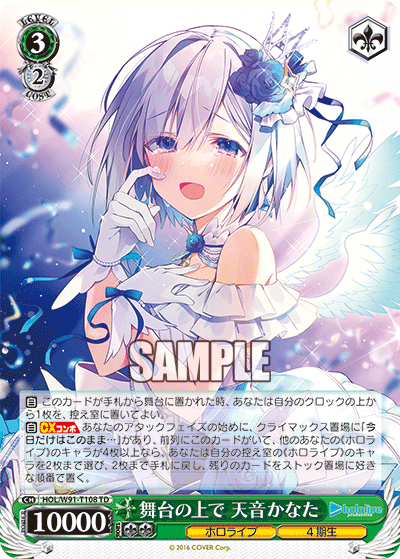
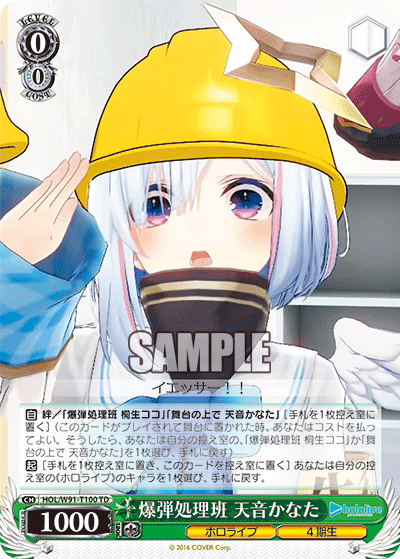

HOL/W91-T100TD 爆弾処理班 天音かなた (center)
HOL/W91-T106TD 得意げ 天音かなた (right)
One other set of cards, or more specifically, a combo, that was on the hot seat in popular discussions among my locals was for the removal or interruption of one part of this three card trio. I think it’s quite well known and agreed upon that Kanata is one powerhouse of a combo. Kanata is quite consistent and provides a plethora of other bonuses thanks to both its supportive cards in the center and right. Kanata herself allows you to salvage characters to hand or stock them as you wish in a modular fashion while also providing heals. Keep in mind that she works with a stock soul to also give you even more additional advantage there. Her card in the center, the aptly nicknamed Kanata Helmet, bonds to both of the level three’s pieces, the level three herself and the backup. The Kanata Helmet can also perform its Helmet ability to grab even more pieces from your waiting room. Lastly, Kanata’s backup is the change target that turns into Kanata. If need be, you can even salvage her from Kanata’s combo to protect Kanata or potentially change again the following turn.
So what is the problem with Kanata? Kanata creates an unhealthy game loop as she stalls your opponent out at level two while continuously providing you additional advantage. Kanata is also incredibly consistent, and even as a level two combo, she very much generates all the resources you need for the late game. She’s the perfect early play I’d say in the current game, and every other early play combo looks with envy. There is a problem with limiting Kanata herself as a design. For a long while now, many early combos have been starting to look like Kanata in one way or form but being worse ultimately by lacking either a heal, modular resource gain, or being less consistent. Kanata is essentially the queen of her category. Taking down Kanata will make it clear that her play pattern or her pieces are unhealthy by design. The question that follows is what will players think of her other clones from different sets? As such, Kanata is in a precarious position. Even though she isn’t touched by the current ban list, we’ll have to see what will happen. As many of my own locals have predicted, there’s a good chance that the good ol’ Kanata and Marine decklist will be reappearing soon again.

I’ll be very real here. I’m not sure what they even want with this card at this point. You has been slowly moving off the ban list with a single copy each time. At this point, they may as well fully remove her from the ban list. I have nothing else to say. At two copies, she’s more consistent than her single copy, but at three, there’s very little reason to not just make her four at this point. You was threatening back in her prime, but given how strong finishers are nowadays, unless there’s a way to constantly abuse and reuse You’s ping ability while ensuring she guarantees several shots of damage, she’s rather mediocre as a result.
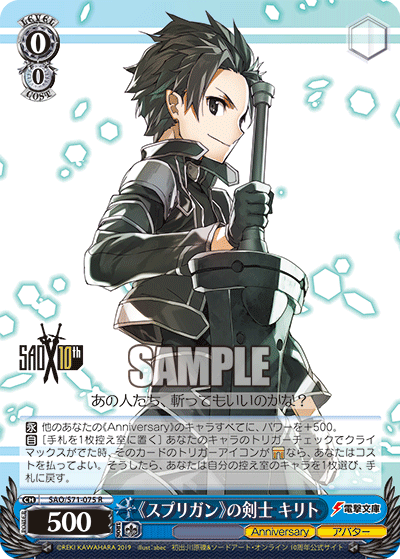
Spriggan Kirito is loose again. Kirito is a very powerful climax filter. Any deck running some amount of arc climaxes would see him as a more than welcome addition to their deck. I don’t think Kirito will cause any huge problematic issues in the current game.
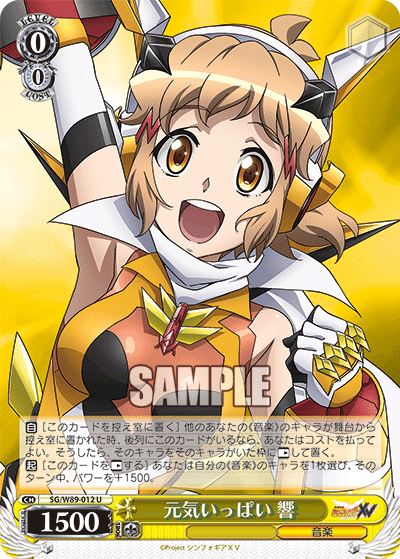
The Pina profile Hibiki is off the list. This Pina profile was a problem earlier for the twins’ deck with Kirika and Shirabe. Given that both the Shirabe finisher and Kirika changer are still on the list, it’s unlikely that removing Hibiki will impact the game in a deep fashion. The card is still great since you can still have a cheap encore ability for either your 3/2 Kirika or 3/2 Shirabe. However, getting to either copy of Kirika or Shirabe without imploding due to the speed of the game is much harder now. The twins are still quite strong if you do manage to get three copies on field early on, but we’ll just have to see.
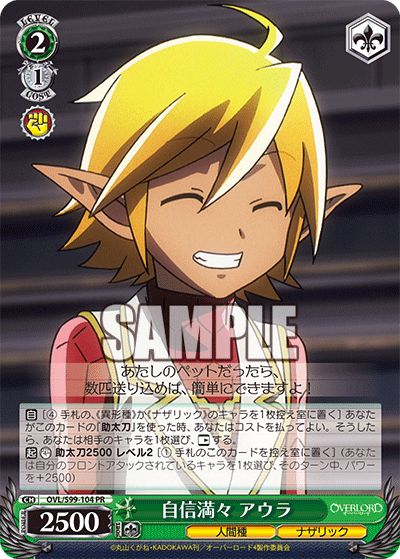

For Overlord, both Aura counters, which are essentially the same cards, are unlimited. Having rest counters is powerful, and in the right situation, they can definitely save you. However, with the 1/1 Ainz still on the banlist, I don’t think there’s any chance that Bone Daddy will be returning any time soon.
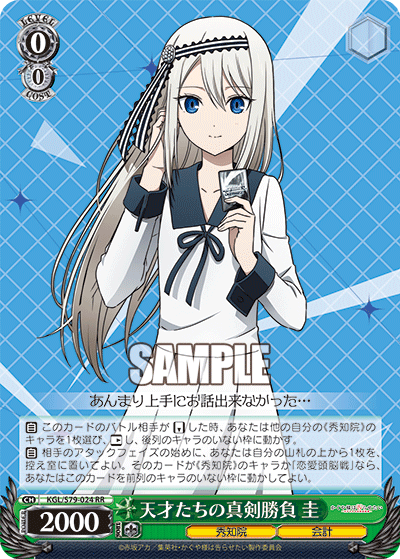
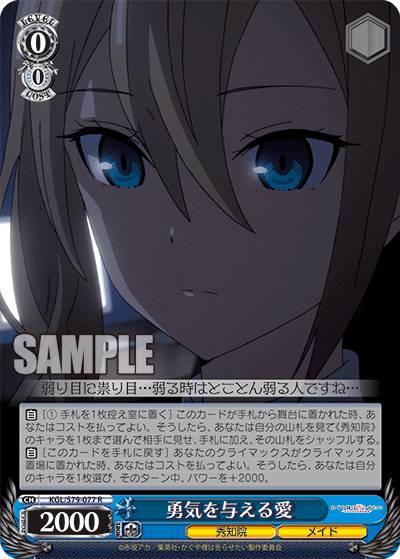
For Kaguya, the last part of this ban list review, Kaguya is fully unlimited now. Kei and Ai are both off the ban list. Kei is an extremely powerful card back in her prime, being both a clean cut and mill runner profile. She could work in conjunction with Ai to send her to the back row to bounce her back to hand whenever you play a climax. Ai herself is a drop search that can return to your hand to give a massive power pump to one of your characters. I think Ai is still a phenomenal profile. A drop search profile is one of the best ways to add consistency to your deck, and with Ai being able to be brought back to hand, she allows you to recycle this ability over and over. Kei, on the other hand, feels a little dated. Her profile is strong, but given how the game has changed from Kaguya’s hay-day, it feels a little underwhelming in the modern game.
And after all that, we’re finally done with the ban list. What do you think? How do you feel? Were the bans justified? Was it right to remove all these cards from the restriction list?
We have another article that speaks about generalization and its effects on powercreep. If you want to take a look, feel free to here.